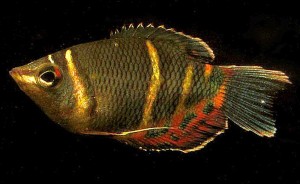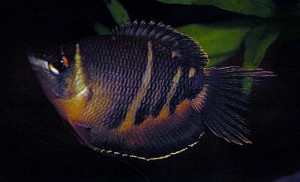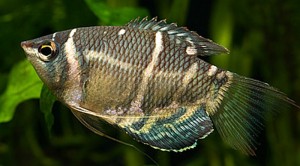Chocolate Gourami (Sphaerichthys osphromenoides osphromenoides) are found in the Malay Peninsula, Sumatra, and Borneo throughout the Malaysian state of Sarawak and the Indonesian province of West Kalimantan (Kalimantan Barat).
Like other Anabantoidei, they possess a labyrinth organ that allows them to breathe atmospheric air to survive in oxygen depleted conditions that would kill most other species.
Chocolate Gourami are mainly found in the blackwater peat swamps and adjacent streams of their range, and sometimes in clear water areas that are tannin stained a dark brown color by the decomposition of leaves, brush, and other organic materials. The humic acids and other chemicals released as decomposition occurs is beneficial to the fish and causes the water to turn a dark brown, to almost black color. The decomposition also causes the pH of the water to drop into the 3.0 or 4.0 range and results in a negligible dissolved mineral content.
Because their normal habitat is found under the dense jungle rain forest canopy in slow moving waters littered with fallen tree branches, brush, and rotting leaves where very little light is present, the fish should never be kept in a brightly lit tank with a strong current.
The clearer water habitats where Chocolate Gourami are sometimes found are similar in terms of water chemistry, but in many cases cause aquatic vegetation to grow profusely. Utricularia, Cryptocoryne, Blyxa, Barclaya, Eleocharis, and Lymnophila are representative genera of these areas.
Male Chocolate Gourami are colored a brown with white vertical stripes.
The males have a yellow border along the edge of their unpaired fins and in some populations, the fins of the male are more blueish or reddish.
Some male populations have more deeply forked caudal fins and more extended dorsal and anal fins. Adult males have a straighter lower jaw profile than females and a more acuminate head shape. The lower jaw is also slightly rounded because of the distensible skin that expands during mouthbrooding.
Chocolate Gourami are a shy, very timid, and slow moving species that should be housed in a biotope system with at least 6 to 8 of their own kind.
They have been collected along with Glowlight Rasboras (Trigonopoma pauciperforatum), Giant Pikehead (Luciocephalus pulcher), Nandus nebulosus, Brilliant Rasboras (Rasbora einthovenii), Dwarf Rasbora (Boraras maculatus), Java Combtail (Belontia hasselti), Betta waseri, Betta Tussyae, Crescent Betta (B. imbellis), and the Striped Glass Catfish (Kryptopterus macrocephalus).
All are slow moving, blackwater species that can be considered candidates for a biotope blackwater “community” aquarium.
Sphaerichthys osphromenoides osphromenoides can be housed in a densely planted 20 gallon or larger aquarium, with a sandy or fine gravel substrate covered with dried leaf litter, and lots of driftwood roots or branches for cover, in the form of small caves. Oak, Beach, or Ketapang Indian Almond Leaves are necessary to replicate the blackwater conditions these fish are found in and to keep the pH in the water low. As they decompose in the tank, the microbe colonies provide a secondary food source for the fish and fry. The tannins and chemicals released are known to be medicinal and to prevent fungal infections. The leaves or leaf litter can be removed and replaced every few weeks or so, or left in the tank to fully decompose.
Some tropical fish keeping enthusiasts place lengths of PVC plastic pipe or ceramic flowerpots in the tank for hiding places, but aesthetically, bogwood or driftwood roots are preferred. Low light loving plants such as Microsorum, Taxiphyllum, Cryptocoryne, and Anubias are recommended for the tank.
To keep Chocolate Gourami healthy, soft water and a low pH is critical. And, because they live in still, slow water environments under the jungle canopy, there should be very low lighting and very little or no current in the aquarium. Adding some floating plants to the tank is an effective method for diffusing the light.
Avoid large water changes that can drastically change the chemistry of the system. A 10 to 15% water change every week is more than adequate. This species should only be kept in an aged aquarium.
Like the Samurai Gourami (Sphaerichthys vaillanti), Chocolate Gourami (Sphaerichthys osphromenoides osphromenoides) are mouth brooders.
However, unlike Samuari Gourami, Chocolate Gourami are maternal mouthbrooders where the female broods the eggs. This is unique in that the only other anabantoid species where the female broods the eggs is the Crossband Chocolate Gourami (Sphaerichthys selatanensis).
Chocolate Gourami can be bred in a group or as a single pair as long as the water quality and their conditioning diet is maintained.
To initiate breeding, use peat extract and a pH of 6.2 in a breeding tank. Lower the water level and raise the water temperature gradually over a two day period by 2° and then slowly add some cooler water to the tank.
The male will normally imitates courtship which can be recognized when the male takes on a dark almost gray patterning. The females color will intensify into a deep chocolate brown, with the light vertical bars turning into an almost golden color.
The pair remains almost upright during the spawning, which may take several hours to accomplish. The eggs are laid and fertilized on the substrate where the female then collects them into her mouth. Both the male and female will guard their territory until spawning is completed. The female will then go to a quiet area in the tank where she will remain until the eggs hatch and the fry are fully formed. This usually takes from 7 to 20 days, during which time the female does not eat. After the fry are fully formed, the female releases from 10 to 40 free swimming fry from her mouth.
At this point the female should be removed from the breeding tank. A tight fitting cover should be placed over the tank to create the humid air required for the proper development of the labyrinth organ of the fry. They fry are large enough to immediately accept or freshly hatched baby brine shrimp.
During rearing, about 10% of the water in the tank should be changed daily to promote growth and maintain the water quality.
In their natural environment, Chocolate Gourami feed on small aquatic crustaceans, insect larvae, worms and zooplankton. Most wild caught specimens require a steady diet of live or frozen mosquito larvae, brine shrimp, Daphnia, grindal worms
, and bloodworms. They may accept freeze dried bloodworms and even a quality carnivore flake food if the fish have been bred in captivity, but be prepared to stock up on live and frozen foods if you plan to keep this species.
Chocolate Gourami are not often available to tropical fish keeping enthusiasts. The best way to obtain specimens is to special order through specialty dealers or purchase them online. They are usually quite costly.
Minimum Tank Size: 20 gallons
Care Level: Difficult
Temperament: Shy, Peaceful
Aquarium Hardiness: Moderately Hardy
Water Conditions: 77-81°F, 1-4 dH , pH 6.0-7.0
Max Size: 2″
Color Form: Brown, White
Diet: Carnivore
Compatibility: Biotope setup
Origin: Asia; Sumatra, Borneo, Malay Peninsula
Family: Osphronemidae
Lifespan: 5-8 years
Aquarist Experience Level: Intermediate or better





One Response to “Chocolate Gourami (Sphaerichthys osphromenoides osphromenoides)”
Trackbacks/Pingbacks
[…] Chocolate Gourami (Sphaerichthys osphromenoides), male Crossband Chocolate Gourami (Sphaerichthys selatanensis) are colored brown with white […]